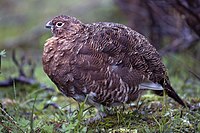
Photo from wikipedia
Snow may prevent Arctic herbivores from accessing their forage in winter, forcing them to aggregate in the few patches with limited snow. In High Arctic Greenland, Arctic hare and rock… Click to show full abstract
Snow may prevent Arctic herbivores from accessing their forage in winter, forcing them to aggregate in the few patches with limited snow. In High Arctic Greenland, Arctic hare and rock ptarmigan often forage in muskox feeding craters. We therefore hypothesized that due to limited availability of forage, the dietary niches of these resident herbivores overlap considerably, and that the overlap increases as winter progresses. To test this, we analyzed fecal samples collected in early and late winter. We used molecular analysis to identify the plant taxa consumed, and stable isotope ratios of carbon and nitrogen to quantify the dietary niche breadth and dietary overlap. The plant taxa found indicated only limited dietary differentiation between the herbivores. As expected, dietary niches exhibited a strong contraction from early to late winter, especially for rock ptarmigan. This may indicate increasing reliance on particular plant resources as winter progresses. In early winter, the diet of rock ptarmigan overlapped slightly with that of muskox and Arctic hare. Contrary to our expectations, no inter-specific dietary niche overlap was observed in late winter. This overall pattern was specifically revealed by combined analysis of molecular data and stable isotope contents. Hence, despite foraging in the same areas and generally feeding on the same plant taxa, the quantitative dietary overlap between the three herbivores was limited. This may be attributable to species-specific consumption rates of plant taxa. Yet, Arctic hare and rock ptarmigan may benefit from muskox opening up the snow pack, thereby allowing them to access the plants.
Journal Title: Oecologia
Year Published: 2018
Link to full text (if available)
Share on Social Media: Sign Up to like & get
recommendations!